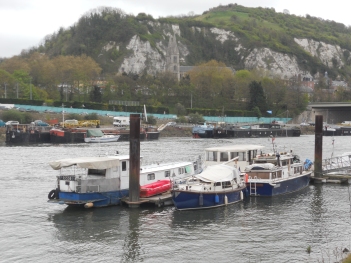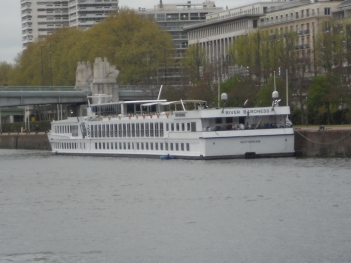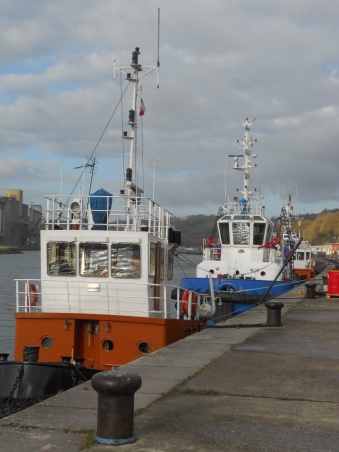Some of us live in war zones, and some of us are lucky enough to live in peace. A great many places have felt the full power of war, creating and destroying history in equal measure. Normandy is one such region of France where the evidence of war sits silent, witness to former invasion.

When I arrived in Rouen nearly three years ago I took the city at face value. The antiques quarter, the cathedral quarter, the colombage timberwork, the redbrick, and the postwar ‘communist’ style concrete river frontage. Each element having its own undoubted character and atmosphere.
Then last a year last summer I had the great fortune to find myself outside the Musée de Beaux Arts on the final day of the Impressionist Exhibition, and was drawn inside like a moth to a flame. I was fully expecting to find myself in front of the ‘waterlillies’ but was astounded to find myself in front of a series of paintings little known to the vast majority of public, lent by private collections, many of which I am unable to reproduce, but all of which depicting views in and around Rouen in the time of Monet.
Monet stayed in Rouen between the years of 1892 – 1898 while painting his famous series on the Cathedral, and produced a wide variety of paintings of the Seine in various media, along with his friends Pissarro and Gaugin.
Today, as I wandered the Seine trying to determine where he would have placed his easel, what came into sharp focus was the riverside architecture at the time of the Impressionists, in comparison with the post war buildings we find today.
Whilst the post war Rive Droite retains its verticality, the war wiped out the classic stone architecture with their shop fronts and awnings, their mansards and tall chimneys for a bland concrete sprawl.

The Bouldieu Bridge, here painted by Pissarro exists today, but not in it’s original form. Even at the time of the Monet, the long masted ships and steam boats would have docked at Rouen, their wares being transported up river by barge just as the container ships of today are offloaded onto ‘peniches’ to continue their journey to Paris. The bridge was destroyed on the morning of 9 June 1940 by the French, just 52 years after its construction to prevent the progress of the German forces. The new Pont Bouldieu built in 1955 equally provides a source of inspiration to the modern day artist Arne Quinze.
But how the river traffic has changed…

I spent hours walking the Seine before realising that Monet had placed himself on the Rive Gauche east of the Ile Lacroix. Not immediately finding his vantage point, this painting gave me a clue.

The Ile Lacroix is one of the few areas of Rouen riverside which retains its greenery.

Sadly this abundant greenery from this painting taken from the Rive gauche no longer exists. I took artistic liberty to take the view from the other direction.
The Seine below Rouen has changed beyond all recognition, swathes of building taken out in bombing raids, industrialisation and the construction of huge grain stores sadly change all but the moody aspect of the skies!


But inspired by Monet I enjoyed watching the rivercraft passing, or moored to the posts which remain to this day. Watching the ‘peniches’ (barges) making their way steadily upriver laden with coal, sand or gravel I thought about how they formed makeshift bridges ‘end to end’ laterally across the river for allied access until the new bridges were constructed at the end of the war.
The moody weather didn’t detract from the activity on the river, nor from the craft moored there.
The chalk cliff of Côte St Catherine remains, dominating the eastern flank of the city.
 From Côte St Catherine Monet painted his famous view of Rouen.
From Côte St Catherine Monet painted his famous view of Rouen.
Sadly, as much as the tall masts from the Armada celebrations in 2008 evoke a little of the sense of the river at the time of Monet, where masts and steam competed for dominance, we can never reclaim the architecture – the rubble long since cleared and replaced.
Had it not been for Monet, would I have ever wondered what was there before?

… thanks to the Impressionists artistic genius, I have at least an idea what the Seine and the Rouen quayside was like before the hand of war had its say.
Where do you live?

This post is part of the Expat Blog Hop – Feel free to hop from blog to blog, but in the meantime tell me where you live and leave your email for a opportunity to receive a free momento of ‘Monet’s Seine’.
 The American Girls Art Club in Paris
The American Girls Art Club in Paris





























Pingback: Monet’s Seine and the Hand of War. | Da Rouen et zalentours | Scoop.it
I so love your blog, I didn’t realise Rouen was such a beautiful city! We pass by on our way from Brussels to Brittany (our 2 expat homes!) but now you have given me an excuse to stop off and discover! Thx, enjoy the blog hop! Lizzi
ps feel free to check out my blog on Brittany at http:thebeachhousefrance.wordpress.com and on Brussels at http://lifewithlizzi.wordpress.com
liz@visualinstinct.be
LikeLike
oops! hit the button too soon, the brittany blog is on http://thebeachhousefrance.wordpress.com
thx lizzi
LikeLike
Thanks Lizzie, I had a quick snoop at your beachhouse and was very tempted!
LikeLike
What a wonderful post! I always look longingly at the river front in Rouen every time I’m heading for the Calais, I must, must, stop off and have a good look around.
LikeLike
You must – and stop for a quick drink too!
LikeLike
Great photos and thanks for introducing us to some lesser-known Impressionist paintings. Hope the blog hop goes well for you.
LikeLike
What was amazing at the gallery were the sheer numbers of paintings by Monet. Having been here over a year at the time I just loved being able to place all the pictures. It was all the more satisfying somehow. Lucky the people that have them hanging in their own private collections!
LikeLike
A great post today. Having been here for only 20 months there is still so much to see and do – thankfully some of it can be experienced from the chair in the bureau. Will be back again to spend more time.
LikeLike
I have to say yes to that. I am looking forward to reading your exploits as a dormant architect.
LikeLike
As a fellow Blog Hopper I will tweet your blog, because I am nice like that.
LikeLike
Thank you – !
LikeLike
A very interesting post, looks a fantastic area.
LikeLike
Such beautiful pictures – thank you for sharing. Monet has associations with Fresselines I believe, which isn’t so very far away.
I love how you put the thumbnails next to the list of blog participants – way beyond my technological powers!
Thanks for taking part in the blog hop. I hope you’ve enjoyed it!
LikeLike
One thing I’ve learnt about learning something new is repetition. 18 blogs later, I reckon i’ve got htumbnails down to a fine art!!!Not so the first one!!
LikeLike
Lovely post – I am so impressed with your photos of comparison between now and Monet’s time, made me want to go to Rouen! Cezanne said of Monet that he was “only an eye” adding “but what an eye” – I think you have a good eye too and its been great to “hop” with you today
LikeLike
Oh I love cezanne’s quote!
LikeLike
Watching the river traffic on the Seine is one of my favorite things to do in Paris, so I truly enjoyed seeing your photos and Monet’s paintings of it in Rouen. Next time I see a barge making it’s way upriver, I’ll wonder if you saw it as well.
I particularly liked comparing the clouds/skies in your photos with the ones in the paintings. Somehow Monet managed to capture and convey the essence of the French sky. I guess that’s one of the many reasons why his paintings continue to have such an impact on us.
Happy Expat Blog Hop Day!
LikeLike
I love looking at the peniche’s as they go up. We always marvel at the small car parked on top! There’s a barrage at Poses, a little further towards Paris where we can stand directly overhead and watch them pass by before going for a drink in the local café where line dancing is ALWAYS taking place!
LikeLike
I forgot to leave my email when I wrote my comment. It’s mkoutandabout@gmail.com
Also, I’m impressed that you were able to add photos next to everyone’s links. I had a hard enough time just trying to figure out what to do with the HMTL code.
LikeLike
It took a while but was fun to do, and gave me the chance to preview everyones blogs at the same time.
LikeLike
So beautiful! I have to return to Rouen one of these trips and take a stroll along the Seine – after following your breakfast tips 🙂
LikeLike
I am really looking forward to next week sharing the experience with my husband finally back from Nigeria. The Café de l’Epoque is particularly charming. If only the rain would disappear, I would enjoy another walk!
LikeLike
Beautiful post! I’ve always had a soft spot for Rouen – now even more so.
LikeLike
It’s a place that has increasingly grown on me, after stubbornly thinking I could only be happy in the south!
LikeLike
I’ve just popped to the bookstore and bought both your books – I adore the Pyrenees and so nearly bought a house in Asson (fell through sadly) and couldn’t resist a good read from my favourite area!
LikeLike
We drive through Rouen heading from Poitou-Charentes to Calais. We really must spend a little more time next time. Nice to have met you via the blog hop!
LikeLike
This post was so beautiful! Water Lilies just takes away from all of these other paintings that truly take you back in time. And I’m so impressed at your only speaking French during the day! if only I had the will power and courage to do so! Nice to meet you via blog hop! -Kristen
LikeLike
Thanks Kristen, My children still look very embarrassed when I speak French in their presence though. That’s what comes of children becoming bilingual before their parents!
LikeLike
This is really nice. The impressionists got it right! I stopped in Rouen one summer just because of Monet. I had to see that cathedral! 🙂
LikeLike
Lovely post; and paintings by Monet that I have never seen. I had a stint doing “figuration” (while a student many years ago) at Theatre des Arts in Rouen and I got to know the place very well. I loved it.
LikeLike
What a fascinating and beautiful post! It sends a shiver down the shine to see how some of the scenes survive almost intact. So glad I found your blog through the blog hop.
LikeLike
Shiver down the shine??? Spine!
LikeLike
Wonderful post, really good job combining images, history and art history. Found you through blog hop, which is a super project. After this I’ll try to follow you in your French version. I’m an American cyclist who loves riding there.
You asked for emails. I’m at snmcycling@gmail.com.
LikeLike
Thanks Suze, I don’t write everything in French because it takes me longer and i’m not sure how comprehensible the french really find me anyway!!
LikeLike